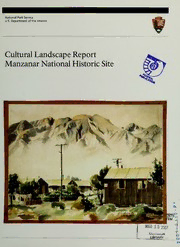
Cultural Landscape Report: Manzanar National Historic Site PDF
Preview Cultural Landscape Report: Manzanar National Historic Site
National Park Service U.S. Department ofthe Interior Cultural Landscape Report Manzanar National Historic Site Digitized by the Internet Archive in 2012 with funding from LYRASIS IVIembers and Sloan Foundation http://archive.org/details/culturallandscapOOmanz Cultural Landscape Report Manzanar National Historic Site National Park Service Pacific West Region 2006 The authors wish to thank all of those who contributed to the development and completion of this report, including: ProjectTeam The OlmstedCenterforLandscape Preservation JeffBurton,Archeologist(WACC) RobertPage,Director CathyGilbert,ProjectLead (PWR-Seattle) CharliePepper,DeputyDirector JohnHammond,HistoricalLandscapeArchitect(PWR- GinaBellavia,ProjectManager Oakland) AmyHoke,HistoricalLandscapeArchitect(PWR-Seattle) CaliforniaState Historic PreservationOffice RobbynJackson,HistoricalArchitect(PWR-Oakland) KimballKoch,HistoricalLandscapeArchitect(PWR- EugeneItogawa Oakland) AnnaTamura,LandscapeArchitect(PWR-Seattle) UniversityofOregon LeonardWarner,Historian (PWR-Oakland) Kenneth Helphand,Professor,DepartmentofLandscape NPSContributors Architecture WACC RonaldBeckwith,Archeologist, OtherConsultants, Reviewers, andAdvisors DebbieBird,ActingSuperintendent,Manzanar ErinBrasfield,ParkGuide,Manzanar ManzanarCommittee GordonChappell,Historian,PWR-Oakland ManzanarAdvisoryCommission SueKunitomiEmbrey SusanDolan,HistoricalLandscapeArchitect,PWR-Seattle Kathleen Fitzgerald,LandscapeArchitect,PWR-Oakland BillMichael ArchieMiyatake FrankHays,Superintendent,Manzanar HenryNishi AnnHuston,ActingSuperintendent,Manzanar RoseOchi ElaineJackson-Retondo,ArchitecturalHistorian,PWR- ArthurOgami Oakland JoyceOkazaki Lori Kleifgen,GPSSpecialist,SantaFe DennisOtsuji TomLeatherman,Superintedent,Manzanar MasOkui AlisaLynch,ChiefofInterpretation,Manzanar MartinandSusanChaffeyPowell RichardStewart KimLinse,ParkRanger,Manzanar Richard Potashin,ParkRanger,Manzanar NelsonSiefkin,Archeologist-FireManagement GlennSimpson,ProjectManager,SantaFe CoverArt:Paintedin 1943byC.I.Morimotodepictinga JohnSlaughter,FacilityManager,Manzanar viewofBlock 19,Manzanar. (CourtesyUCLASpecial StephanieToothman,Chief,CulturalResourcePrograms, Collections) PWR-Seattle JaneWehrey,ParkRanger,Manzanar Forsalebythe SuperintendentofDocuments,U.S. GovernmentPrintingOffice Intemet: bookstore.gpo.gov Phone: toll free(866)512-1800 DCarea(202) 512-1800 Fax: (202) 512-2250 Mail: StopSSOP,Washington,DC20402-0001 ISBN lbD77mM-7-3 Contents PARTI Introduction i Historical Overview i ManagementSummary 2 Scope andMethodology 4 SiteBoundaries 6 Site History 8 Prehistory 8 1829-1902: Euro-American Explorationand EarlySettlements 8 1902-1941: WaterReclamationinthe OwensValley 15 TheOwensValleyImprovementCompanyandtheTown ofManzanar 19 1942-1945:WarRelocationCenters 24 ANationMobilizesforWar 24 Site Selection 29 Designand ConstructionStandards 31 Initial ConstructionatManzanar 32 Camp DesignandDevelopment 40 BarracksBlocks 41 Medical Facilities/HospitalComplex 50 Securityand Surveillance Structures 50 Administration 53 Factories,Warehouses,andIndustrial Production Facilities 53 WRA ModificationsandAdditions 55 Landscaping, GroundsCrews,andMaintenance 59 ParksandPicnic Grounds 78 Cemetery 81 1945-Present: ClosingoftheManzanarWarRelocationCenter 82 Existing Conditions 95 PhysicalSetting 95 LandUse 96 Accessand Circulation 97 NaturalSystems 99 Ornamental Vegetation 100 BuildingsandStructures 102 Archeological Resources 107 Analysis and Evaluation 108 Introduction 108 NaturalSystems 109 SpatialOrganization in CulturalTraditions n4 Vegetation 146 Circulation 165 BuildingClustersand Structures 171 Archeological Resources 212 PART 2 Treatment 225 Introduction 225 Treatment Guidelines 229 Circulation 229 Historic BuildingsandStructures 238 Archeology 244 Vegetation 246 Firebreaks 261 Soil ConservationandGrading 262 Small-scale Features 264 Schematic Design Concepts 267 AutoTourRoute 267 Highway395 269 GuardTowerNo. 8 271 HistoricEntrance 271 Interpretive Center (Auditorium) 273 DemonstrationBlock 276 Cemetery 281 Bibliography 286 Appendices AppendixA: ManzanarSite Bulletin: Glossary AppendixB: LandOwnership Overlays 1920, and 1945. AppendixC: "HistoricOrchardCharacter",bySusanDolan. Excerpt from2006 DRAFTChapter3,FruitfulLegacy:AHistoricContext ofFruitandOrchardsinthe UnitedStates,from1600tothePresent, National ParkService, PacificWestRegion,Olmsted Centerfor Landscape Preservation,NationalCenterforCulturalResources. Appendix D: SummaryTablesofArcheologicalResources, compiled byJeffBurton,WesternArcheological andConservationCenter, National ParkService, Summer2005. Table D.i.ArcheologicalSitesRecordedWithinManzanarNational Historic Site Table D.2. DesignatedArcheological FeaturesandLociatManzanar NationalHistoricSite Table D.3. ManzanarRelocationCenterCentralArea (MANZ 1993 A-30)Archeological Features AppendixE:TripReport,October9,2003: Fire Management Recommendations,ManzanarNational Historic Site,NelsonSiefkin, Archeologist, FireManagement, PWR,June 18,2003. AppendixF: ListofClassifiedStructures,ManzanarNationalHistoric Site Introduction Introduction Historical Overview On February 19, 1942, President Franklin D. Roosevelt signed Executive Order9066, leadingto the relocation and internment of120,000Japanese Americans.Tocarryouttheorder,theUnitedStatesGovernmentestablished 10 War Relocation Centers in Arizona, Arkansas, California, Wyoming, Utah, Idaho, and Colorado. Manzanar was the first center to open as the OwensValleyReceptionCenter. Itheldatotalofn,070JapaneseAmerican citizensandJapanese immigrants duringWorldWarII. On March 5, 1942, approximately one week after the Manzanar site was chosen, the U.S. Corps of Engineer's office in Los Angeles solicited bids for the construction ofbarracks, utilities, and other camp infrastructure. The firsttruckloads oflumberarrived on March 14. Inthe followingdays, workers began clearing the land and constructing the buildings. ByApril, buildings were being raised at the rate oftwo an hour and 25,000 board feet oflumberwere beingused every 10 minutes. Construction continued atthispace overseveralmonths. On June i, 1942, camp operations transferred from the Army's Wartime Civilian ControlAdministration (WCCA) totheWarRelocationAuthority (WRA), a federal agency established by President Roosevelt on March WRA 18, 1942, by Executive Order 9012. The was authorized to formulate and execute a relocation program to provide shelter, clothing, medical attention,andeducationalandrecreationalfacilitiesforinternees.ByJune, 1, 1942,9,666JapaneseAmericanswere confinedatManzanar. The War Relocation Center occupied 6,000 acres, but only the core area ofthe camp, approximately 550 acres, housed the internees. Enclosed by abarbedwire fence and surrounded by eightguard towers, each ofthe36 blockswithinthiscentralareacontained14barracks,amesshall,recreation hall, laundryroom,ironingroom, andtwolatrine buildings. Inadditionto thishousingarea,thecampalsoincludedanadministrativeareaandhousing Manzanar National Historic Site Parti forWRAstaff,warehouses,factories,andahospital.Theinterneesusedthe firebreaks within the camp for recreation, and, in some cases, these open spaceswere plantedwith rowcrops, orchards, andVictorygardens. Many internees built ornamental gardens thatincorporated stylistic elements of traditionalJapanese American design such as ponds, small bridges, paved paths,rockfeatures,andvegetation. Inadditiontothesegardens,relatively large public parks were built in the northern portion ofthe camp. Large- scaleagriculturaloperationsweredevelopednorthandsouthofthefenced camp and were maintained by internees. All of the ornamental gardens and agricultural crops were watered by an extensive irrigation system that included a diversion, reservoir, and miles of hand-dug ditches and channels. The population of internees at Manzanar reached a peak of 10,046 on September22,1942.By1944,thepopulationhaddecreasedsignificantly.The last internee left the camp November 21, 1945. WRA personnel occupied the camp for several more months to close out operations and work with other agencies to dispose of the camp's surplus property. Most barracks and other buildings were sold for re-use or scrap. Those remaining were condemnedanddemolished. Today,the mostvisible remains ofthe camp arethe two stone sentryposts at the entrance, the auditorium building, and the cemetery. The barbed wire fence that historically enclosed the camp has been reconstructed and defines the extent of the core area ofthe historic camp. In addition, there are numerous archeological (structural) features including concrete foundations, remnant gardens, portions of the extensive water system, vegetation, roads and other infrastructure that define the historic extent andcharacterofthe site. More than40 years afterthe lastinternee leftManzanar, Congresspassed the Civil LibertiesAct of1988, acknowledging "agrave injusticewas done to both citizens and permanent residents of Japanese ancestry by the evacuation, relocation,andinternmentofcivilians duringWorldWarII." In 1972, Manzanar was designated a California Historic Landmark (No. 850A). In 1976, it was Usted in the National Register of Historic Places, and in 1985, designated a National Historic Landmark. The National Park Service evaluated all 10 War Relocation Centers in the mid-1980s for possible inclusion to the National Park System. Based onthis assessment, Manzanar was determined to have the greatest potential as a unit of the Cultural Landscape Report
